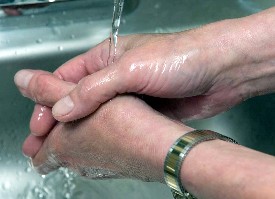Researchers at Johns Hopkins University School of Medicine in Baltimore, Maryland have found that electronic faucets — the kind that dispense water from an electronic signal — are more likely to become contaminated with high levels of bacteria, compared with traditional manual faucets. The study will be presented on Saturday at the annual meeting of the Society for Healthcare Epidemiology of America.
Electronic-eye, non-touch faucets are used increasingly in commercial and hospital settings to lower water consumption and, in the case of hospitals, reduce recontamination of the hands of health care staff. Emily Sydnor, an infectious disease fellow and colleagues examined bacterial growth from faucets of two clinical wards at Johns Hopkins Hospital from December 2008 through January 2009. Their study, in which the hospital’s facilities and engineering departments took part, included cultures taken from 20 manual faucets and 20 electronic faucets, each receiving water from the same source.
The findings showed that 50 percent of water cultures from electronic faucets grew Legionella bacteria species compared to 15 percent of water cultures from manual faucets. Sydnor also found more water cultures from electronic faucets had significant growth on heterotrophic plate count (HPC) cultures — an international standard measurement of the number of bacteria in the water — than water cultures from manual faucets, although the HPC rates were not statistically different.
Even following a flush of the water system using chlorine dioxide — a common disinfectant used in water systems — the disparity between electronic and manual faucets persisted. After the cleaning, 29 percent of electronic faucet cultures were still contaminated with bacteria compared with 7 percent of manual faucet cultures.
Sydnor speculated that the increased bacterial growth in electronic faucets may be due to contamination of the numerous parts and valves that make up the faucet. During the course of collecting water samples, researchers discovered that all of the electronic faucet parts grew Legionella bacteria.
She noted that the levels Legionella bacteria exceeded the tolerable thresholds determined by the hospital, which would be potentially dangerous for chronically ill or immune-compromised patients because of the threat of pneumonia in these patients. However, the levels of Legionella and HPC rates were still within the level considered well tolerated by healthy individuals.
Following the study, Johns Hopkins Hospital decided to replace electronic faucets in clinical areas with manual faucets, and will not to install electronic faucets in clinical areas of its new hospital building.
Read more: CDC Awards Grants to Reduce Health Care Infections
* * *


 RSS - Posts
RSS - Posts
You must be logged in to post a comment.